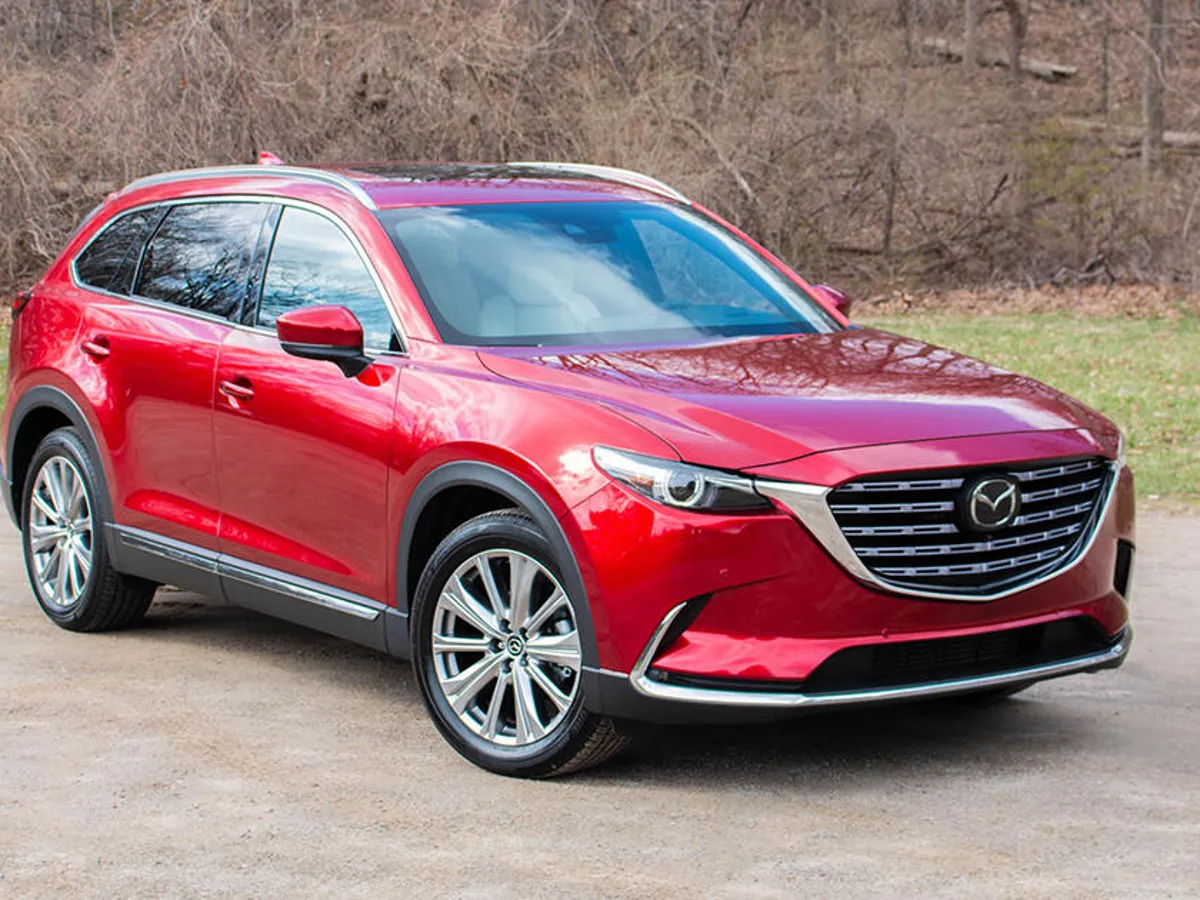People often walk into a car dealership stating they want “a reliable car, one that’s going to last.” But how can anyone truly know how long a vehicle will last?
The team at iSeeCars.com tackled this question by analyzing data from over 402 million vehicles to determine which ones are most likely to stay on the road for at least 250,000 miles.
“Many consumers still consider a car’s usable lifespan to end at 100,000 miles. But our latest longest-lasting study confirms that even 200,000 miles isn’t the end of the line for many cars.
Cars That Still Get Good Mileage at 200K Miles
Most cars start to feel their age long before the odometer hits 200,000 miles—but not all. Some models defy expectations, delivering solid fuel economy and reliable performance well past the point where most vehicles would be on their last legs.
Whether you’re hunting for a dependable used car or aiming to keep your current ride running strong, these long-haulers prove that good mileage doesn’t have to die with age.
In this article, we highlight the cars that still get impressive fuel efficiency even after crossing the 200K mile mark—because durability and economy don’t have to be mutually exclusive.
Nissan Armada
12.6% hit 250,000 miles
The first-generation Nissan Armada debuted in 2003, built on the same platform as the Nissan Titan.
By mid-2016, the second-generation Armada transitioned to the Nissan Patrol platform, though it received several adjustments tailored for the U.S. market.
Essentially, it shares much of its design with the Infiniti QX80, but comes at a lower price point. Full-size three-row SUVs have long been considered an American stronghold just look further up the rankings.
However, Nissan (along with Toyota) has consistently provided a distinctive option that could set you apart in the school pickup line every weekday afternoon at 3:00 p.m.
According to Nissan, the Armada is all-new for the 2025 model year. It now features a twin-turbo V6 engine that replaces the outgoing V8.
This new engine delivers 425 horsepower and 516 lb-ft of torque, which is an increase of 25 horsepower and 103 lb-ft over the previous 5.6-liter V8. So it’s certainly not lacking in power.
Pricing for the 2025 Armada starts at $58,530 and ranges up to $79,000 for the top-of-the-line Platinum Reserve trim.
We often like to believe that technological advancements automatically lead to better vehicles across the board. But sometimes, progress involves trade-offs—and that’s the case with the 2025 Nissan Armada.
The latest model replaces a long-running V-8 engine, originally introduced in 2002 and paired with a Jatco seven-speed transmission from 2008, with a thoroughly modern twin-turbo V-6 and a nine-speed automatic.
The new setup delivers more horsepower and torque, enough to offset the inevitable weight gain that typically comes with redesigns. City fuel economy improves significantly—up by 15 percent. So, where’s the letdown?
This is where things get puzzling. Despite the technical improvements, both the new Infiniti QX80 and Nissan Armada are slower than their outgoing versions—though the new Armada nearly matched its predecessor.
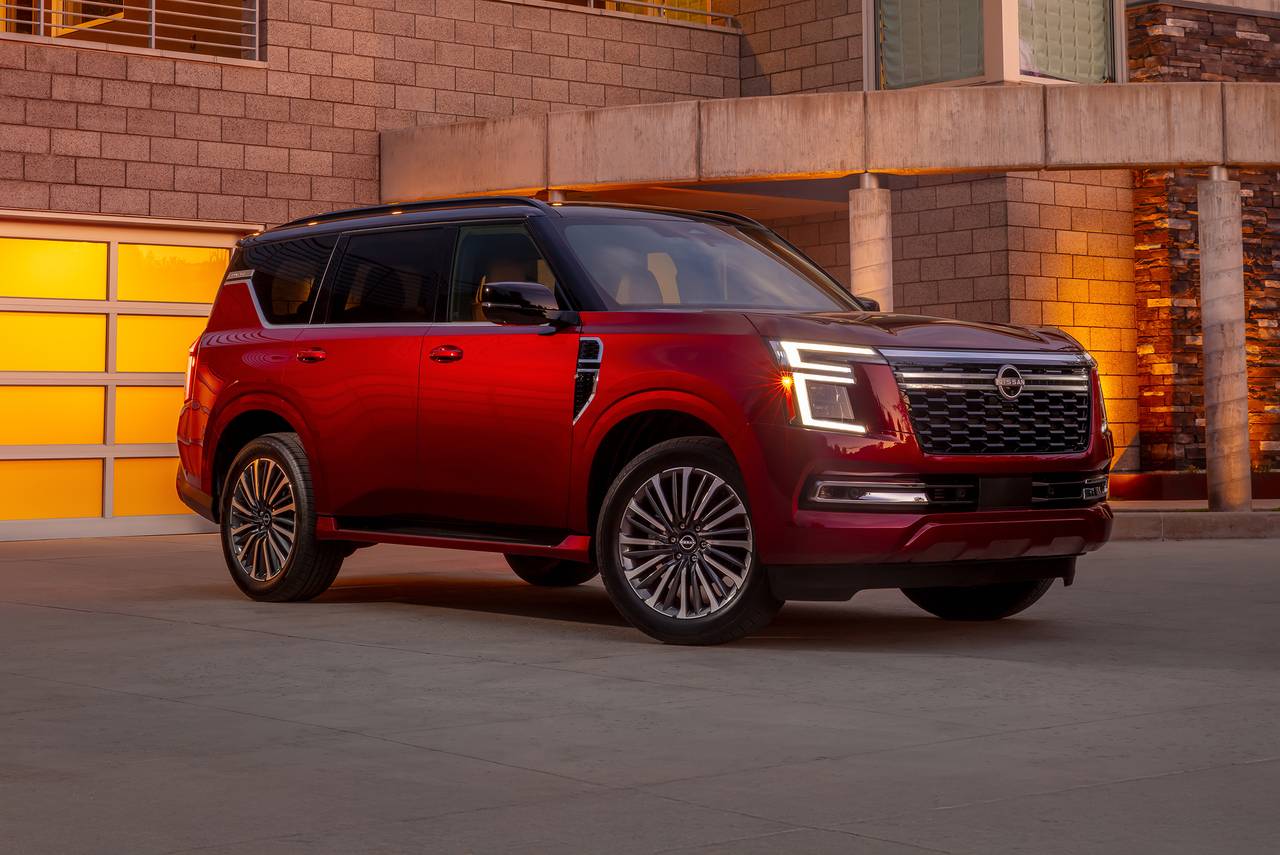
Weight-to-power ratios have improved—by 6.3 percent in the Nissan and 12.5 percent in the Infiniti—and with two extra gears, there’s 15 to 21 percent more torque multiplication in the lower gears (first through third). On paper, these vehicles should outperform the previous generation by a wide margin.
Yet, the Infiniti clocks in at half a second slower to 60 mph, and the Armada lags just a tenth behind (6.3 vs. 6.2 seconds). By the quarter-mile, they close the performance gap: the Nissan ties at 14.8 seconds, hitting 1.3 mph higher, and the Infiniti is 0.3 seconds slower but comes in 1.5 mph faster.
Launching from 2,200 rpm with brake-torque, the Armada gets off the line promptly but lacks a punchy feel. This could be due to aggressive torque management at launch or the absence of full-throttle fuel enrichment, which may be holding this GT-R–derived engine back. Repeated runs showed a drop-off in performance, suggesting heat buildup could be affecting output.
Of course, few buyers are looking to race full-size, three-row SUVs. In real-world terms, the Armada sits in the middle of the pack for acceleration—right alongside Toyota’s twin-turbo V-6 hybrid Sequoia TRD Pro.
Those seeking speed should check out the Ford Expedition, which boasts 440 hp and 510 lb-ft of torque, hitting 60 mph in 5.3 seconds and finishing the quarter mile in 14.0 seconds at 96.6 mph.
Or consider the twin-turbo I-6 Jeep Wagoneer (5.4 to 60 mph, 14.2 seconds at 94.7 mph). By contrast, V-8 models from Chevy and GMC bring up the rear, clocking times in the mid-7s for 0–60 and mid-15s for the quarter.
Another curiosity: despite the new transmission’s 14 percent taller ninth gear, highway fuel economy is unchanged at 18 mpg for the air-sprung models. Oddly, the steel-sprung 2025 Armada achieves 19 mpg, suggesting the air suspension’s highway benefit may not be as impactful as expected.
Heavy rainfall during the first drive turned off-road sections into a slick mud pit, rendering the Pro-4X’s Yokohama Geolandar tires nearly useless off pavement.
But they redeemed themselves on tarmac. In our tests, this 6,106-pound SUV came to a stop from 60 mph in just 112 feet—12 feet shorter than the 5,956-pound previous-gen Armada, which already led its class.
Looking at the broader market, only a few SUVs stop shorter, and those are generally smaller models, high-performance variants, or sport-tuned editions. Only the Mazda CX-70 and Buick Enclave beat the Armada’s stopping distance, and both weigh about 1,000 pounds less.
There is one caveat: the Armada’s brake-by-wire system lacks ideal pedal feedback under hard braking—feeling stiff up top, mushy at the bottom, and vague overall. In normal conditions, however, braking feel is completely adequate.
Compared to other off-road-capable SUVs, the Armada Pro-4X holds its own. Riding on 275/60R20 Geolandar A/Ts, it completed our figure-eight course in 28.1 seconds at an average of 0.63 g. Maximum lateral grip hit 0.77 g.
The Ford Expedition still leads, managing a 27.6-second lap at 0.64 g on 265/75R18 Goodyear Wrangler Territory AT/S tires. That truck’s edge comes from stronger straight-line acceleration (0.74 g max lateral), while the Armada claws back time through better braking and tighter cornering.
Toyota’s TRD Pro trails by half a second, and the GMC Yukon AT4 sits at the bottom with a 30.6-second run and 0.66 g grip.
Of course, no one’s entering their full-size SUV in a slalom event. But when the unexpected happens—like a deer or moose dashing across a dark backroad—drivers will value the Armada’s agility.
Mazda CX-9
12.4% hit 250,000 miles
The Mazda CX-9 served as the brand’s largest people mover from 2006 until the end of its production in 2024.
Originally developed through the Ford-Mazda alliance, the early versions of the CX-9 were built on a Ford platform and powered by a Ford V6 engine.
Although it has now been succeeded by the completely redesigned CX-90, the CX-9 had an impressive lifespan. For nearly two decades, it transported up to seven passengers across three rows, making it a dependable family SUV throughout its production run.
There are only a few updates to the 2023 Mazda CX-9 SUV, as Mazda appears to be winding down this model’s run—potentially its final year on sale. With the newly introduced CX-90, a more upscale six-cylinder option now sitting at the top of the brand’s SUV lineup, and with the base Sport trim of the CX-9 discontinued, Mazda currently offers two three-row mid-size SUVs starting just below the $40,000 mark.

Given that the CX-9 originally launched in the U.S. in 2015 as a 2016 model, its time may be drawing to a close. Still, it delivers plenty of value, including a high-end interior and handling that remains genuinely enjoyable.
Its fun-to-drive character is a standout feature—still superior to that of newer competitors like the Hyundai Palisade and Kia Telluride. Despite its age, the CX-9 continues to receive strong safety ratings in every review.
However, while its 250-horsepower four-cylinder engine (when running on premium fuel) is serviceable, it has now been eclipsed by the more advanced mild-hybrid six-cylinder powertrain in the CX-90.
The newer engine not only delivers better performance and fuel economy, but it does so at a price point that’s not significantly higher. So, does that mean the CX-9 is now obsolete?
The Mazda CX-9 Touring begins at $38,750. The next trim, Touring Plus, is priced at $41,350, followed by the Carbon Edition at $44,780.
The Grand Touring version comes in at $45,690, and the top-tier Signature trim is listed at $48,460. These are the manufacturer’s suggested retail prices (MSRP), and a destination fee of $1,375 must be added to each.
When you shift the CX-9 into Drive, it’s easy to forget that this SUV has already been on the market for seven years. Unlike many other vehicles in its segment, it doesn’t feel bulky behind the wheel, instead offering a level of agility rarely seen in similarly priced competitors—unless those competitors also wear a Mazda badge.
The steering may not deliver the same tactile feedback as a Miata, but it remains precise and responsive, adding a level of enjoyment that’s become uncommon in this category.
In an age where many SUVs feel disconnected, the CX-9’s steering makes you feel in command rather than along for the ride. The suspension has a firm quality that supports confident cornering and keeps body roll in check, yet it avoids crossing into uncomfortable territory, even when driving over rough pavement.
For drivers who value engagement, the CX-9 remains an appealing choice, successfully blending driving enjoyment with daily comfort. Its engine, while not remarkable by segment standards, benefits from a solid band of turbocharged mid-range torque that gives it sufficient thrust for most situations.
Acura MDX
11.9% hit 250,000 miles
The Acura MDX came onto the scene as a direct successor and a significant improvement over the SLX, which was based on the Isuzu Trooper and sold by Acura for a few years while parent company Honda was still figuring out the SUV segment.
Fortunately, they figured it out well. Since then, the MDX has remained a cornerstone of Acura’s luxury lineup for the past 25 years.
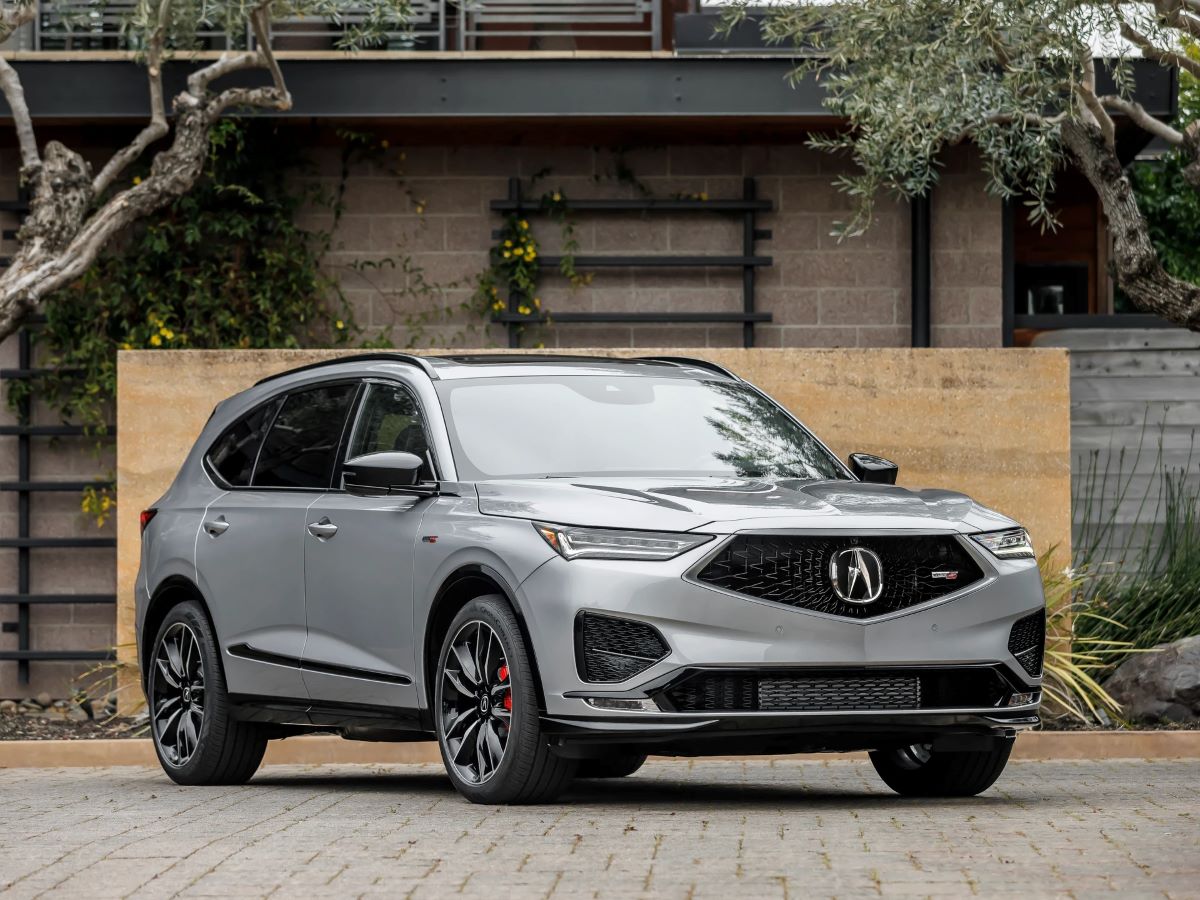
Today, the MDX offers two engine options: a 290-horsepower naturally aspirated 3.5-liter V6 in the base model, and a 355-horsepower 3.0-liter turbocharged V6 in the MDX Type S Advance.
With these choices, the MDX has firmly established its place in the luxury SUV market. Pricing starts at $52,550 and goes up to $76,600.
2025 Honda Odyssey
11.5% hit 250,000 miles
Honda has been building the Odyssey for 31 years, and during that time, the company has consistently researched and surveyed American families to understand exactly what they want in a minivan.
Now in its fifth generation, the Odyssey offers a highly functional interior and yes, even a usable roof rack (as seen with the bicycle).
Inside, you’ll find cupholders, cubbyholes, and ample connectivity options throughout the cabin.
Honda has even included those incredibly useful plastic grocery bag hooks, which arguably should be standard on every vehicle regardless of class.
The second-row seating arrangement is especially inventive in a segment where it seemed innovation had peaked.
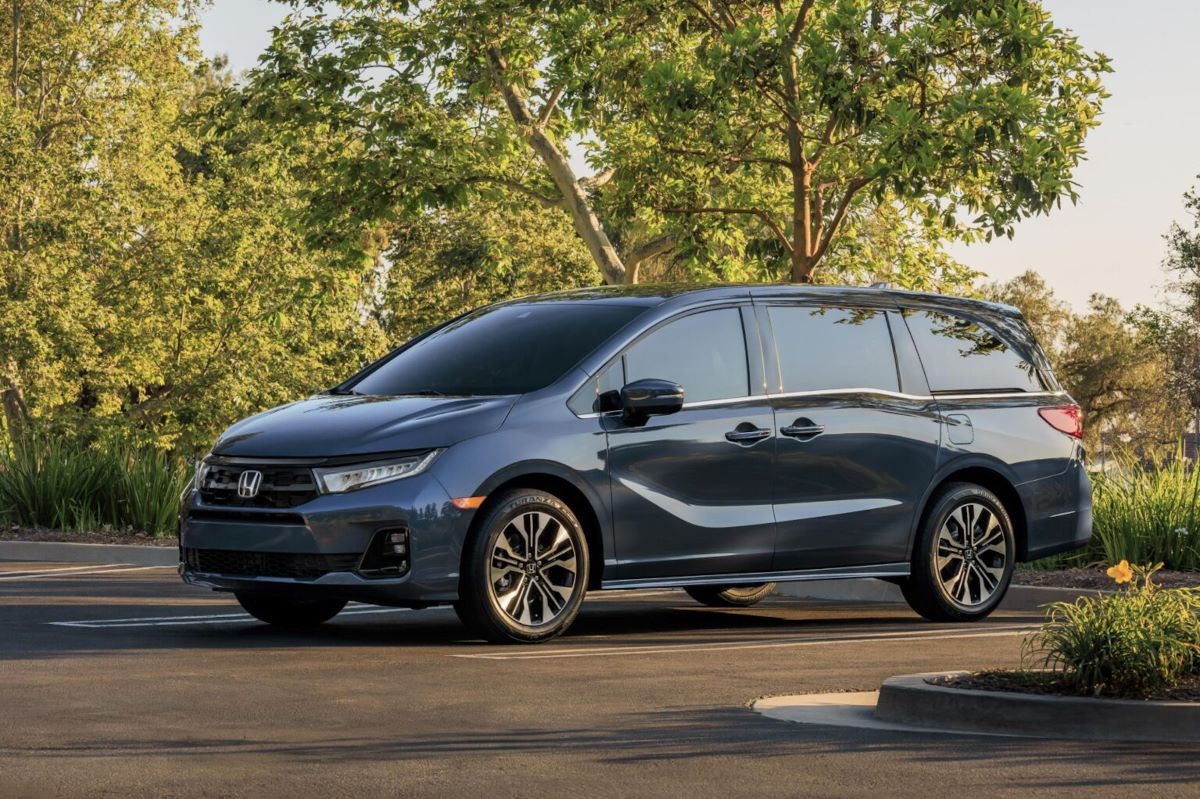
For example, you can remove the center seat and slide the outer seats inward to improve access to the third row.
And speaking of the third row, it’s a full-width, three-passenger bench, meaning this minivan seats eight no matter what whether you need that many seats or not.
Under the hood, the Odyssey is powered by a robust 3.5-liter V6 producing 280 horsepower and 262 lb-ft of torque, enough to propel it to 60 mph in roughly six and a half seconds.
However, this V6 does have a bit of a thirst fuel economy comes in at 19 mpg in the city and 28 mpg on the highway, which is decent but not class-leading.
As for pricing, the Odyssey reflects Honda’s premium positioning, with MSRP ranging from $43,670 to $52,630.
That might be a worthwhile investment, especially considering this van is built to keep going strong up to 250,000 miles and beyond.
RAM 1500
11.5% hit 250,000 miles
The Sterling Heights Assembly Plant in Michigan recently marked a major milestone by producing its 2 millionth Ram 1500, a testament to the truck’s enduring popularity.
Over the years, the Ram 1500 has racked up numerous awards, including Car and Driver’s 10 Best and Motor Trend’s Truck of the Year, among others.
For the 2025 model year, the Ram 1500 introduces two powerful engine options: the 3.0-liter Hurricane and the 3.0-liter Hurricane High Output (H/O) Straight-Six Turbo (SST).
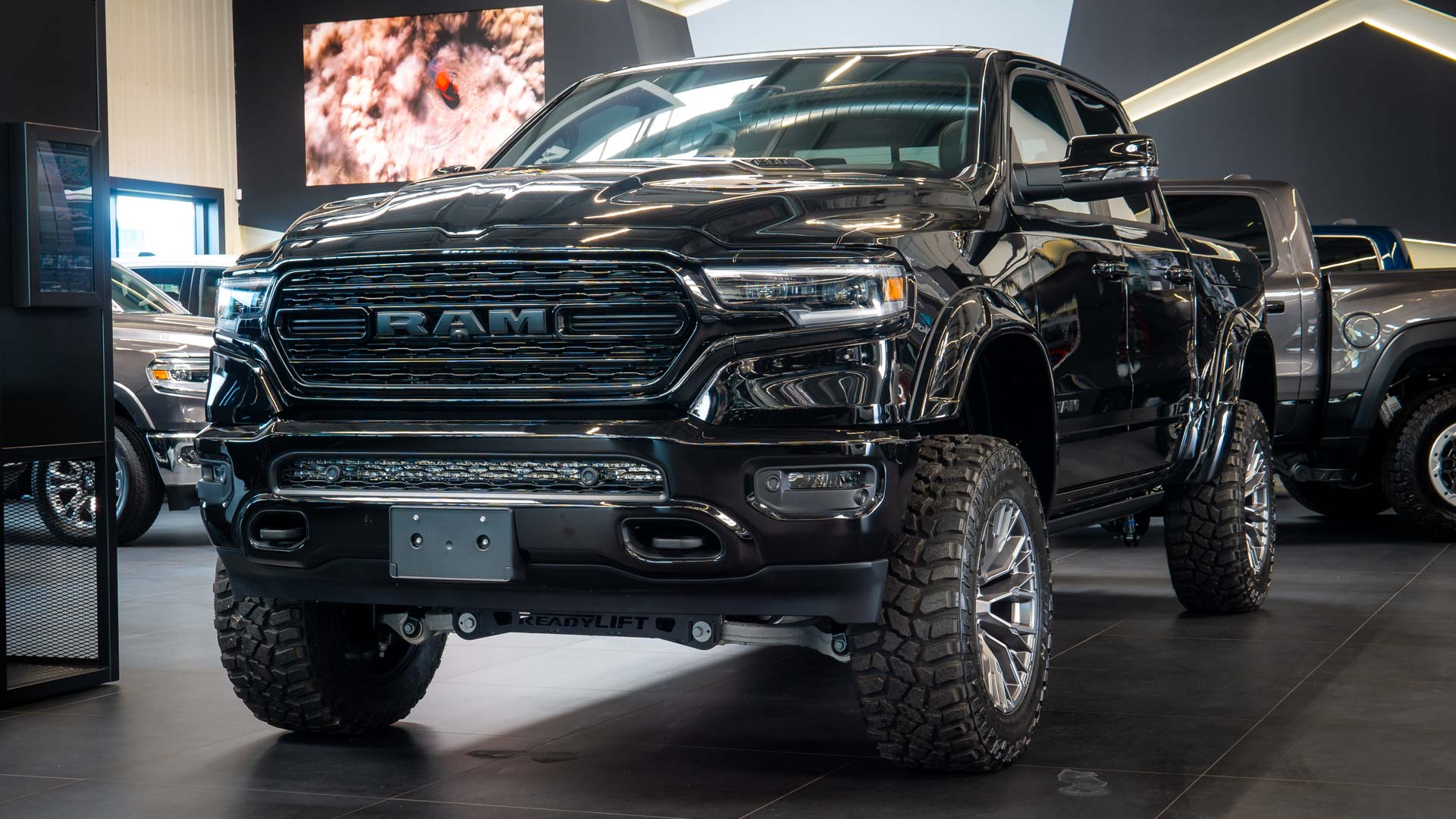
The standard Hurricane produces 420 horsepower and 469 lb-ft of torque, while the High Output version cranks out an impressive 540 horsepower and 521 lb-ft of torque.
In addition, the lineup still includes the reliable 3.6-liter Pentastar V6 with eTorque assistance. Performance capabilities are a major highlight.
The Ram 1500 offers a maximum towing capacity of 11,580 pounds and a payload rating of up to 2,300 pounds. It’s also built for tough terrain, with the ability to ford up to 24 inches of water.
Pricing starts just above $42,000 and can climb to around $89,000, depending on configuration and trim.
Used Cars With the Worst Fuel Efficiency
With the average price of a new car now exceeding $30,000, and fuel costs continuing to stretch your budget at the pump, the type of vehicle you choose has a direct impact on how much you can save each month.
Fuel consumption is a major factor in that equation, so understanding your car’s fuel efficiency is essential to staying financially on track.
To help you avoid buying a car that will drain your wallet with constant fuel stops, GOBankingRates has identified used vehicles from the past decade that deliver the worst gas mileage.
A car’s miles per gallon (MPG) rating affects not only your finances but also the environment.
Unsurprisingly, the biggest gas guzzlers tend to be supercars, hypercars, and high-performance luxury models with six- or seven-figure price tags vehicles that are financially out of reach for most people.
It’s also critical to remember that the vehicle’s sticker price isn’t the only cost to consider. Expensive cars often come with higher auto loan interest rates, particularly for those with less-than-perfect credit.
And even if a car is more affordable upfront, it may end up costing you significantly more over time if it has poor fuel efficiency. Consider these average interest rate benchmarks:
- A new car buyer with excellent credit can expect an average interest rate of 5.25%, but for those with poor credit, that rate jumps to 15.77%.
- For used vehicles, interest rates typically range from 7.13% to 21.55%, depending on credit history.
Because most shoppers aren’t browsing the used market for pre-owned Rolls-Royce Cullinans, Bentley Continentals, or Lamborghini Aventadors, the following list excludes such exotic models.
Instead, it highlights everyday cars, trucks, vans, and SUVs known for their high fuel consumption.
There is one exception, though a supercar whose historically poor fuel economy is simply too extreme to leave off the list.
Also Read: Top 10 EV Features That Come in Useful in Daily Commute
Mercedes-AMG GLA45 4Matic
Combined MPG: 23
As far as station wagons go, the Mercedes-Benz GLA class is about as stylish and appealing as it gets. It has consistently been regarded as one of the top luxury subcompact crossovers available.
However, the AMG-enhanced GLA45 model introduced in 2015 takes things to another level, boasting a turbocharged inline-four engine that delivers 150 more horsepower than the standard version, pushing total output to 382 horsepower.
Of course, with that kind of performance comes a compromise in fuel efficiency. The GLA45 manages just 20 MPG in the city and 27 MPG on the highway, resulting in a combined average of 23 MPG.
The 2024 model comes with a starting price of $53,000, but used versions can be found for under $20,000, depending on the model year and condition.
With a base price in the mid-$40,000 range, the GLA-class remains the most accessible entry into the Mercedes-Benz lineup in the U.S. market.
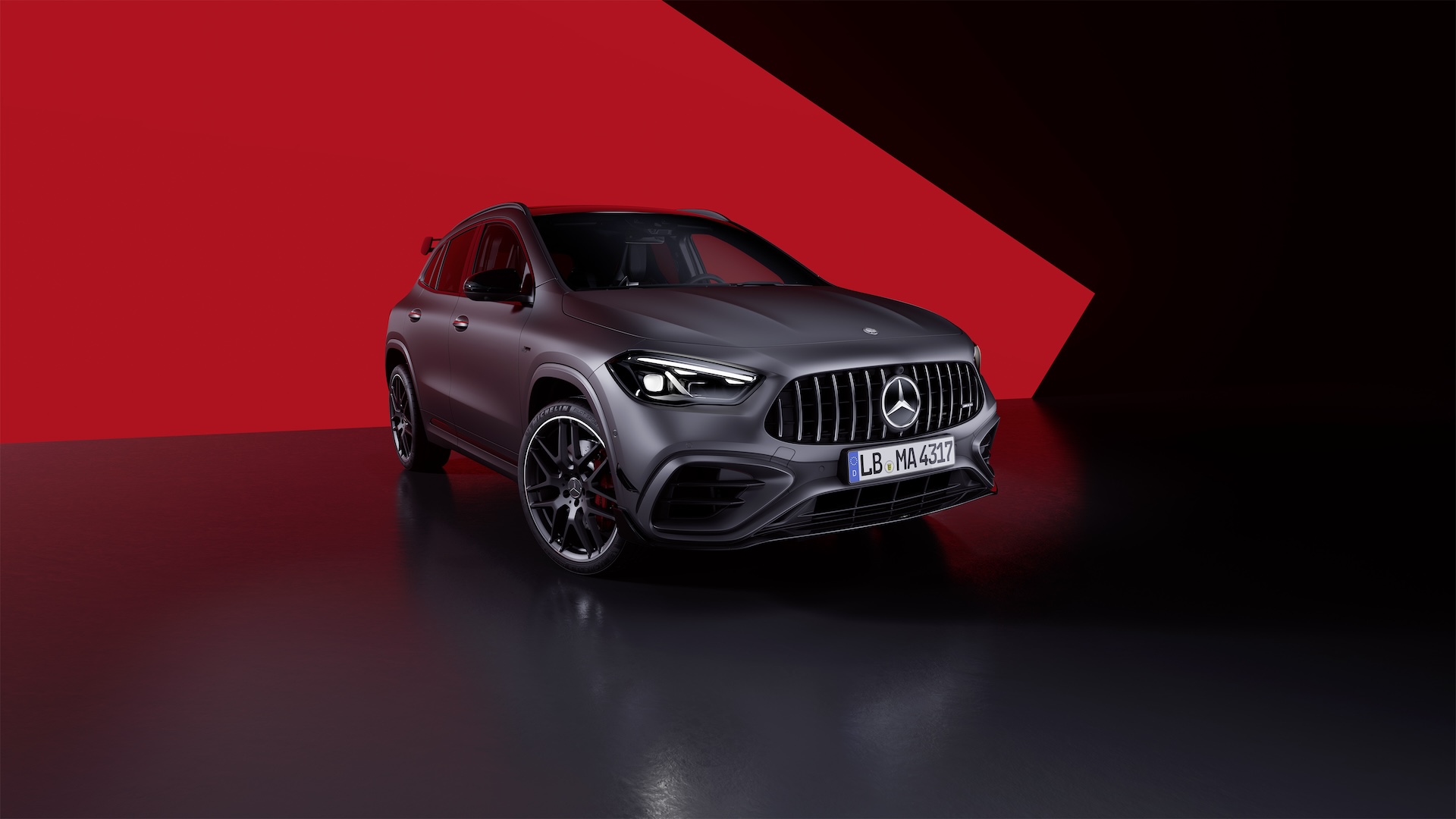
It delivers a glimpse of the brand’s signature luxury and, with its 221-hp engine, provides enough performance to satisfy most buyers. However, for those wanting more excitement, the 2025 Mercedes-AMG GLA-class steps in.
Boasting 302 horsepower and a low-slung, sport-tuned adaptive suspension, it bridges the gap between high-performance hatchbacks and compact crossovers. That AMG-badged performance comes with a price—expect to pay over $10,000 more than the standard GLA. But there’s another compromise: ride quality.
The AMG GLA’s rigid suspension setup may prove too firm for everyday comfort, making a thorough test drive essential before committing.
Competing options include the more budget-friendly but less potent BMW X1 and X2, while drivers looking for a better balance between power and comfort will need to stretch their budget another $10,000 to step into a Porsche Macan.
Following the discontinuation of the 382-hp GLA45, the AMG GLA lineup is now solely represented by the GLA35. That said, the GLA35’s 302-hp output ensures it remains an enticing option, offering engaging performance and an upgraded driving experience compared to the GLA250. The GLA35 includes standard all-wheel drive and a sport-tuned suspension designed to elevate handling.
Our recommended pick is the mid-tier Exclusive trim, which enhances the vehicle with features such as upgraded LED headlights, integrated navigation with augmented reality video, traffic sign recognition, illuminated door sills, and more.
Under the hood, the GLA35 features a turbocharged four-cylinder engine enhanced by AMG tuning, delivering 302 horsepower and now benefiting from a 48-volt hybrid system.
Paired with a snappy dual-clutch automatic transmission, this setup yielded brisk acceleration and a satisfying engine note in our test model, although it lacked refinement during routine city driving. The GLA35 handles responsively, showing minimal body roll in corners, but the trade-off is a notably firm ride.
Even in Comfort mode, the suspension transmits impacts harshly—especially when equipped with the optional 20-inch wheels. Sticking with the standard 19-inch wheels may slightly soften the ride. On the upside, the 20-inch setup helped our test car post an impressive 0.93 g on the skidpad.
At the track, the GLA35 reached 60 mph in just 4.7 seconds using launch control. However, in everyday scenarios, that speed doesn’t always translate—its 5–60 mph time was a more subdued 5.8 seconds, indicating a less urgent feel during casual takeoffs.
EPA estimates peg the GLA35’s fuel economy at 22 mpg in the city and 28 mpg on the highway, aligning closely with competitors like the BMW X2 M35i and the Mini Cooper Countryman JCW.
In our 75-mph highway fuel economy test, the GLA35 returned a slightly better-than-expected 30 mpg. For additional details on fuel efficiency, the EPA’s website offers more information on both the GLA35 and the discontinued GLA45.
The interior of the standard GLA-class is already fairly spacious for rear passengers, and the GLA35 retains that practicality.
For an entry-level AMG model, the interior quality is commendable, and its layout mimics that of higher-end Mercedes SUVs. The GLA35 stands out with sport-oriented design touches like heavily bolstered front seats, red stitching, red seatbelts, a flat-bottom steering wheel, and carbon-fiber trim.
Starting in 2024, buyers have also been able to opt for open-pore wood and other premium finishes. Cargo capacity is reasonable, with a flat load floor that aligns with the sill, simplifying the loading and unloading process.
Nissan Armada 4WD
Combined MPG: 15
The 2024 model year marks the 20th anniversary of the Nissan Armada, a spacious, powerful full-size SUV that originally launched in 2004 as the Pathfinder Armada.
While it retains its traditional body-on-frame design, the current generation introduced in 2017 shifts its underpinnings from the Nissan Titan full-size pickup to the more refined Infiniti QX80 platform.
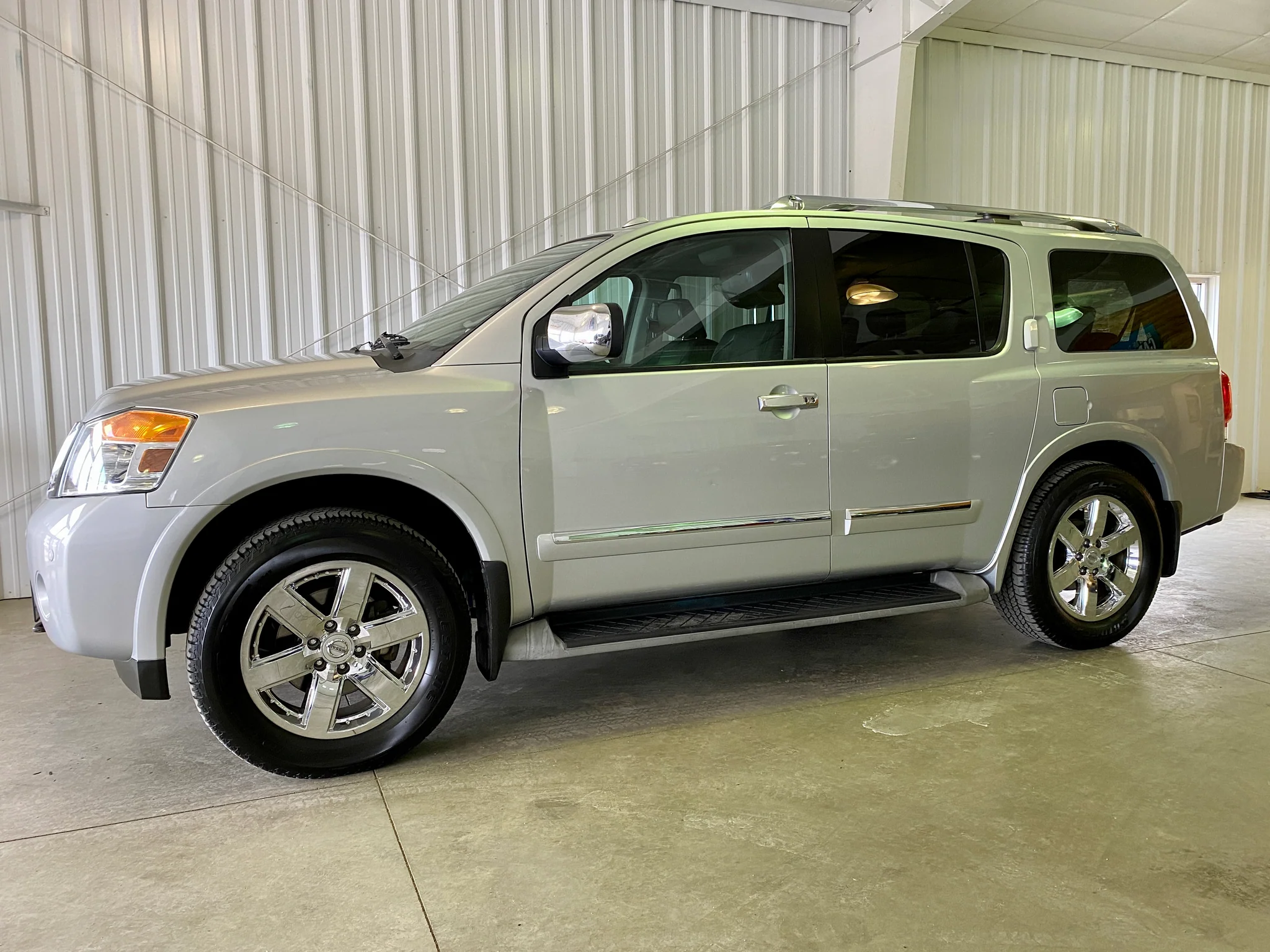
Under the hood, the Armada houses a commanding 5.6-liter V8 engine producing 390 horsepower. However, that impressive power comes at the cost of fuel efficiency.
Take the 2020 model, for instance it delivers just 13 MPG in the city and 18 MPG on the highway, for a combined total of only 15 MPG.
Toyota Sequoia 4WD
Combined MPG: 15
The Toyota Sequoia has been a staple in the full-size SUV segment for over two decades, having debuted in 2000.
While it has received multiple generational updates, its roots in the Tundra pickup have always been apparent especially in its bold front grille and expansive interior.

That truck-based heritage also extends to its thirst for fuel, particularly in the four-wheel-drive versions.
Take the 2018 model as an example: it delivers just 13 MPG in the city and 17 MPG on the highway, resulting in a combined 15 MPG.
For the 2025 model year, Toyota has added the cowboy-themed 1794 Edition to the Sequoia lineup, a trim previously seen on the Tundra pickup.
Sitting above the Platinum and just below the Capstone, the Sequoia 1794 brings unique styling elements and upgraded features. It includes a brown leather interior with walnut woodgrain trim, oversized Texas-style badges, a panoramic sunroof, second-row captain’s chairs, and a standard towing package.
It also gains massaging front seats, which are now standard on the Platinum and Capstone trims as well. However, Toyota has dropped the Solar Octane exterior color, which may disappoint buyers who favored its bold aesthetic.
Among these, the Limited trim offers the best value. Though it’s only a step above the base SR5, it adds significant standard features such as a larger 14.0-inch touchscreen, a power liftgate, 20-inch wheels, heated and ventilated front seats, and a power-folding third row—making it an excellent mid-tier option.
Under the hood, the Sequoia is powered by Toyota’s iForce MAX hybrid powertrain, which is also available on the Tundra. This setup pairs a twin-turbocharged 3.4-liter V-6 engine with an electric motor to produce a combined 437 horsepower and 583 lb-ft of torque.
It’s mated to the same 10-speed automatic transmission found in the Tundra. Rear-wheel drive is standard, while four-wheel drive is optional across most trims and standard on the TRD Pro. The TRD Pro model also features a range of off-road enhancements, including upgraded Fox dampers, a front skid plate, a locking rear differential, and forged 18-inch wheels with 33-inch tires.
Buyers of the SR5, Limited, or Platinum trims can opt for the TRD Off-Road package, which includes trail-capable features like hill-descent control, Crawl Control, and a locking rear differential.
On the road, the Sequoia delivers a comfortable and quiet ride, but its overall driving behavior has some drawbacks.
Its extra-wide footprint makes it feel bulky and difficult to position within a lane—an issue not uncommon among full-size SUVs—and the overly light steering doesn’t help matters. Additionally, the brake pedal feels soft and lacks the firmness expected in a vehicle of this size and class.
Gen 6 Ford Mustang Shelby GT500
Combined MPG: 14
The Mustang Shelby GT500 has a storied legacy stretching back to 1967, with the current sixth generation in production since 2020.
MSRPs range between $74,000 and $80,000, depending on the model year.
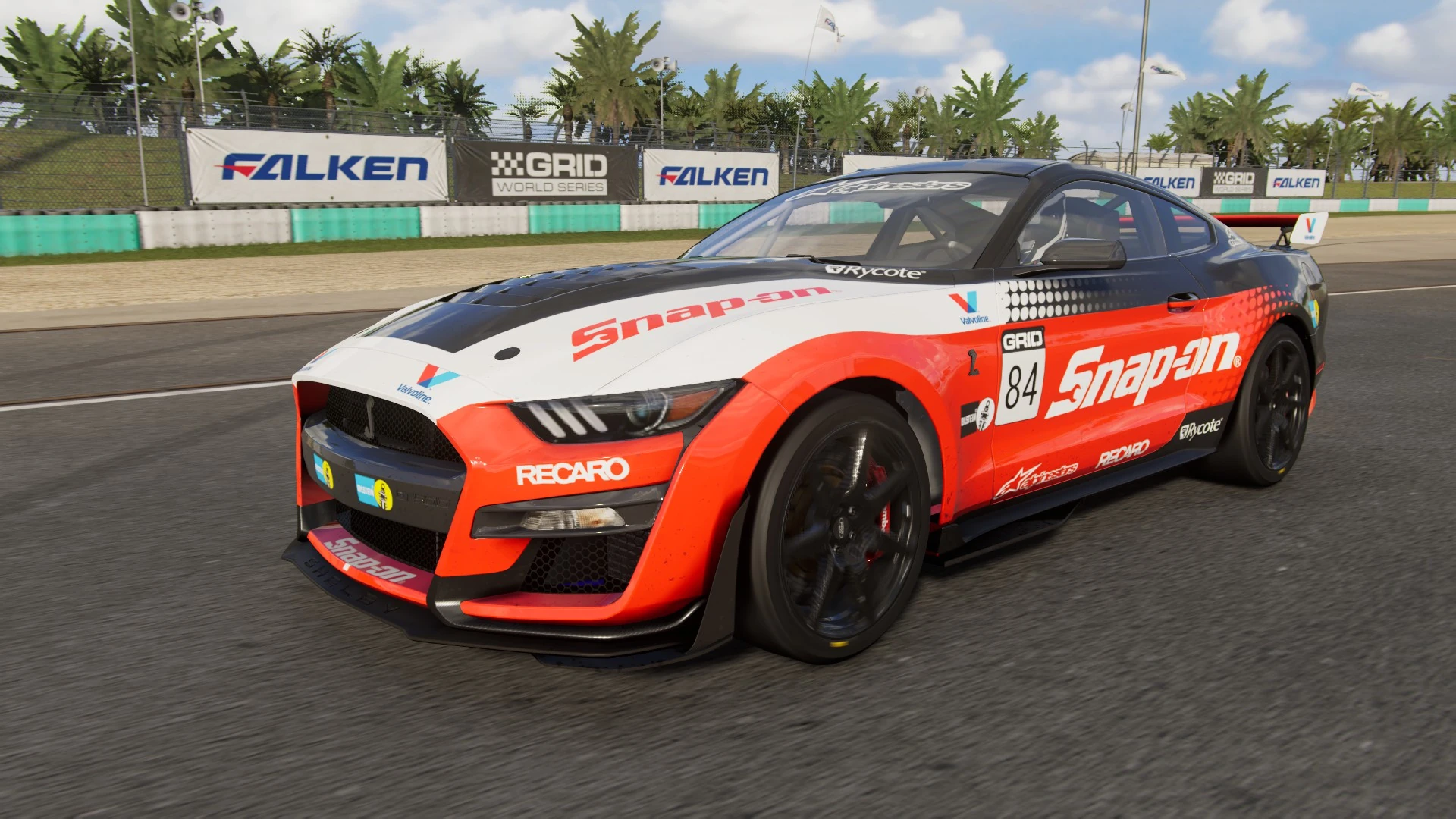
And don’t expect much relief on the used market these cars often retain their value so well that they can sell for more than their original sticker price after only a year or two on the road.
Fuel efficiency hasn’t improved much, either. Though it manages 18 MPG on the highway, it gulps fuel at a rate of 12 MPG in the city, resulting in a combined average of just 14 MPG.
The 2022 Ford Mustang Shelby GT500 Fastback comes as a high-performance package with a starting price of \$80,795. Classified under EPA regulations as a subcompact car, it features a rear-wheel-drive layout that supports its muscle car dynamics.
Under the hood, it houses a powerful 5.2-liter (315 cubic inches) intercooled supercharged V-8 engine, which requires premium unleaded fuel. This engine, designated by order code 99J, utilizes a sequential multi-port fuel injection (MPI) system to deliver exceptional performance.
The GT500 generates an impressive 760 horsepower at 7,300 rpm and delivers a maximum torque of 625 lb-ft at 5,000 rpm, making it one of the most formidable Mustangs ever built.
Although the specific cooling system capacity is not listed, the vehicle is engineered for high-output driving. Power is routed through a 7-speed automatic transmission with overdrive, coded as 44G, which operates using an auto-shift manual setup to balance raw performance with ease of use.
Also Read: Top 5 Cars With Headlights That Fog Up Frequently
Chevrolet Express
Combined MPG: 12
Also marketed as the GMC Savana, the Chevrolet Express was launched in 1996 as the brand’s first all-new full-size cargo van since 1971.
Aside from a few minor updates and modern safety enhancements, today’s Express vans remain largely unchanged from their original design, making it, as Classic Vans notes, “one of the longest-produced automotive designs in North American auto history.”

Known for their versatility, reliability, and spacious interiors, the Express vans have always been fuel-inefficient.
The 2015 model, for instance, achieves just 10 MPG in the city and 15 MPG on the highway, for a combined fuel economy of 12 MPG.

